ACC00716 Finance: Risk and Return Analysis of Bega Cheese using CAPM
VerifiedAdded on 2023/06/13
|5
|1284
|493
Case Study
AI Summary
This case study report analyzes the relationship between risk and return for Bega Cheese using the Capital Asset Pricing Model (CAPM). It explains the CAPM formula, highlighting the importance of the risk-free rate, beta, and market risk premium in determining expected returns. The analysis computes the expected return for Bega Cheese and a hypothetical company, demonstrating the positive correlation between risk and return. A portfolio consisting of both stocks is then evaluated, showing how portfolio risk and return are influenced by the weighting and risk profiles of individual stocks. The report concludes that the CAPM model is a valuable tool for assessing expected returns and the cost of equity. Desklib provides access to similar case studies and study resources for students.
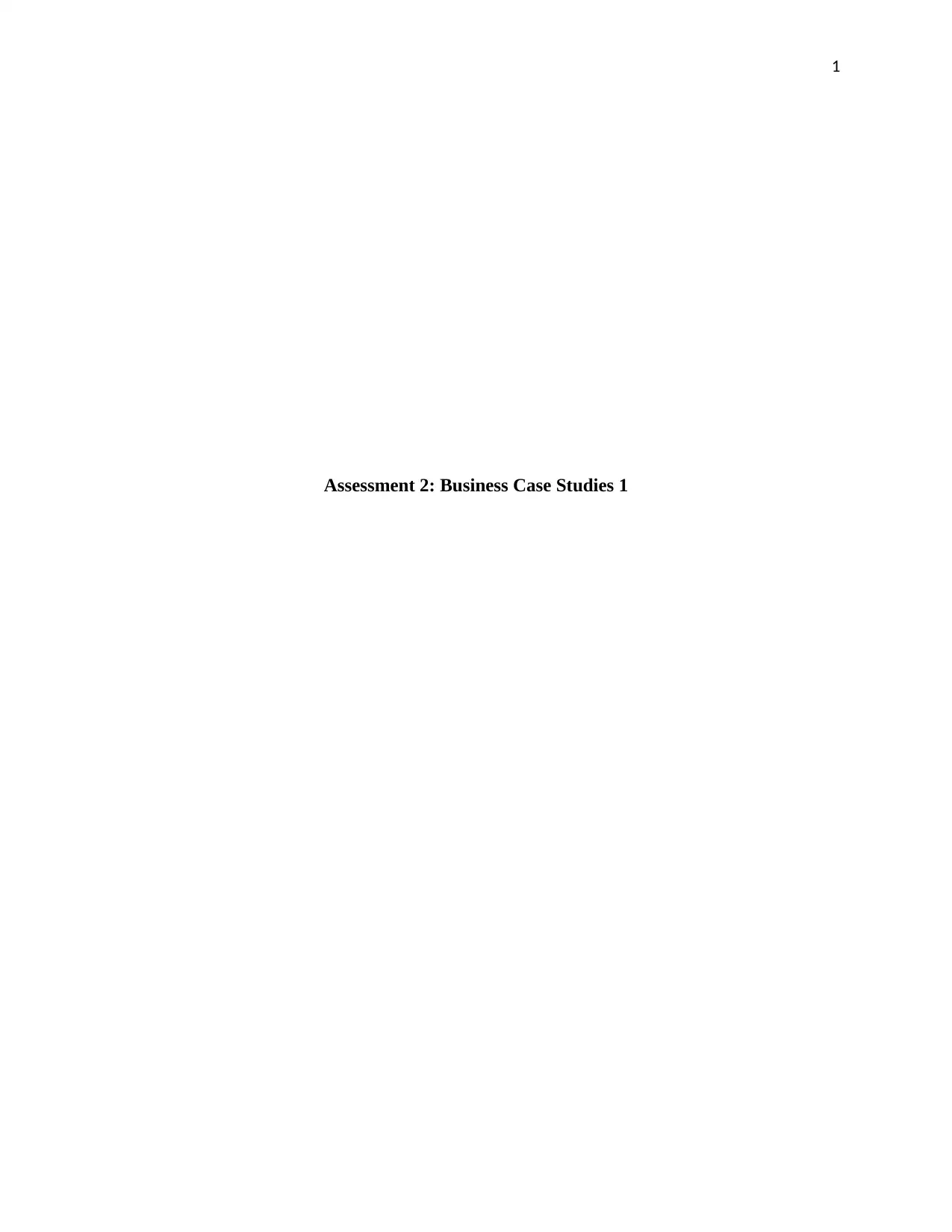
1
Assessment 2: Business Case Studies 1
Assessment 2: Business Case Studies 1
Paraphrase This Document
Need a fresh take? Get an instant paraphrase of this document with our AI Paraphraser
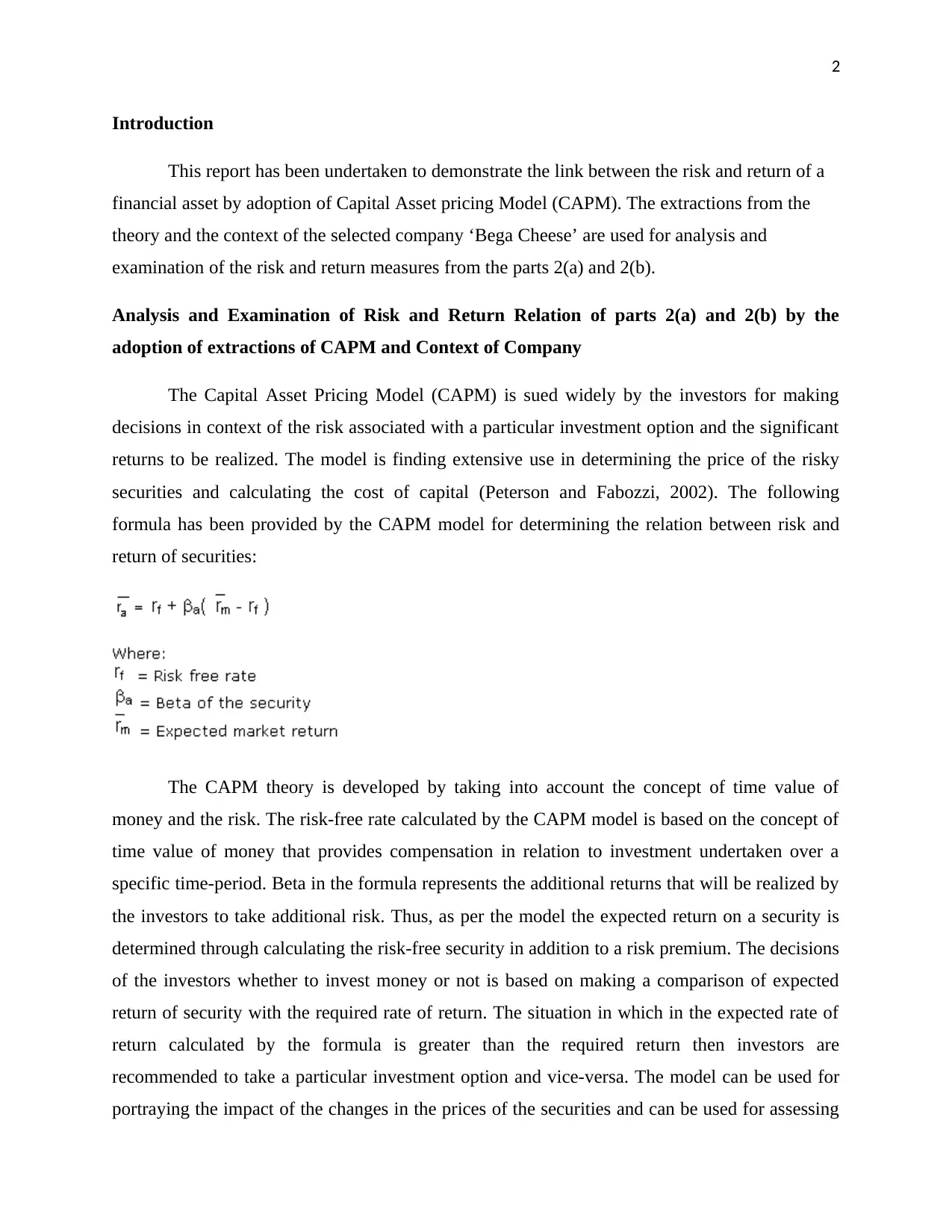
2
Introduction
This report has been undertaken to demonstrate the link between the risk and return of a
financial asset by adoption of Capital Asset pricing Model (CAPM). The extractions from the
theory and the context of the selected company ‘Bega Cheese’ are used for analysis and
examination of the risk and return measures from the parts 2(a) and 2(b).
Analysis and Examination of Risk and Return Relation of parts 2(a) and 2(b) by the
adoption of extractions of CAPM and Context of Company
The Capital Asset Pricing Model (CAPM) is sued widely by the investors for making
decisions in context of the risk associated with a particular investment option and the significant
returns to be realized. The model is finding extensive use in determining the price of the risky
securities and calculating the cost of capital (Peterson and Fabozzi, 2002). The following
formula has been provided by the CAPM model for determining the relation between risk and
return of securities:
The CAPM theory is developed by taking into account the concept of time value of
money and the risk. The risk-free rate calculated by the CAPM model is based on the concept of
time value of money that provides compensation in relation to investment undertaken over a
specific time-period. Beta in the formula represents the additional returns that will be realized by
the investors to take additional risk. Thus, as per the model the expected return on a security is
determined through calculating the risk-free security in addition to a risk premium. The decisions
of the investors whether to invest money or not is based on making a comparison of expected
return of security with the required rate of return. The situation in which in the expected rate of
return calculated by the formula is greater than the required return then investors are
recommended to take a particular investment option and vice-versa. The model can be used for
portraying the impact of the changes in the prices of the securities and can be used for assessing
Introduction
This report has been undertaken to demonstrate the link between the risk and return of a
financial asset by adoption of Capital Asset pricing Model (CAPM). The extractions from the
theory and the context of the selected company ‘Bega Cheese’ are used for analysis and
examination of the risk and return measures from the parts 2(a) and 2(b).
Analysis and Examination of Risk and Return Relation of parts 2(a) and 2(b) by the
adoption of extractions of CAPM and Context of Company
The Capital Asset Pricing Model (CAPM) is sued widely by the investors for making
decisions in context of the risk associated with a particular investment option and the significant
returns to be realized. The model is finding extensive use in determining the price of the risky
securities and calculating the cost of capital (Peterson and Fabozzi, 2002). The following
formula has been provided by the CAPM model for determining the relation between risk and
return of securities:
The CAPM theory is developed by taking into account the concept of time value of
money and the risk. The risk-free rate calculated by the CAPM model is based on the concept of
time value of money that provides compensation in relation to investment undertaken over a
specific time-period. Beta in the formula represents the additional returns that will be realized by
the investors to take additional risk. Thus, as per the model the expected return on a security is
determined through calculating the risk-free security in addition to a risk premium. The decisions
of the investors whether to invest money or not is based on making a comparison of expected
return of security with the required rate of return. The situation in which in the expected rate of
return calculated by the formula is greater than the required return then investors are
recommended to take a particular investment option and vice-versa. The model can be used for
portraying the impact of the changes in the prices of the securities and can be used for assessing
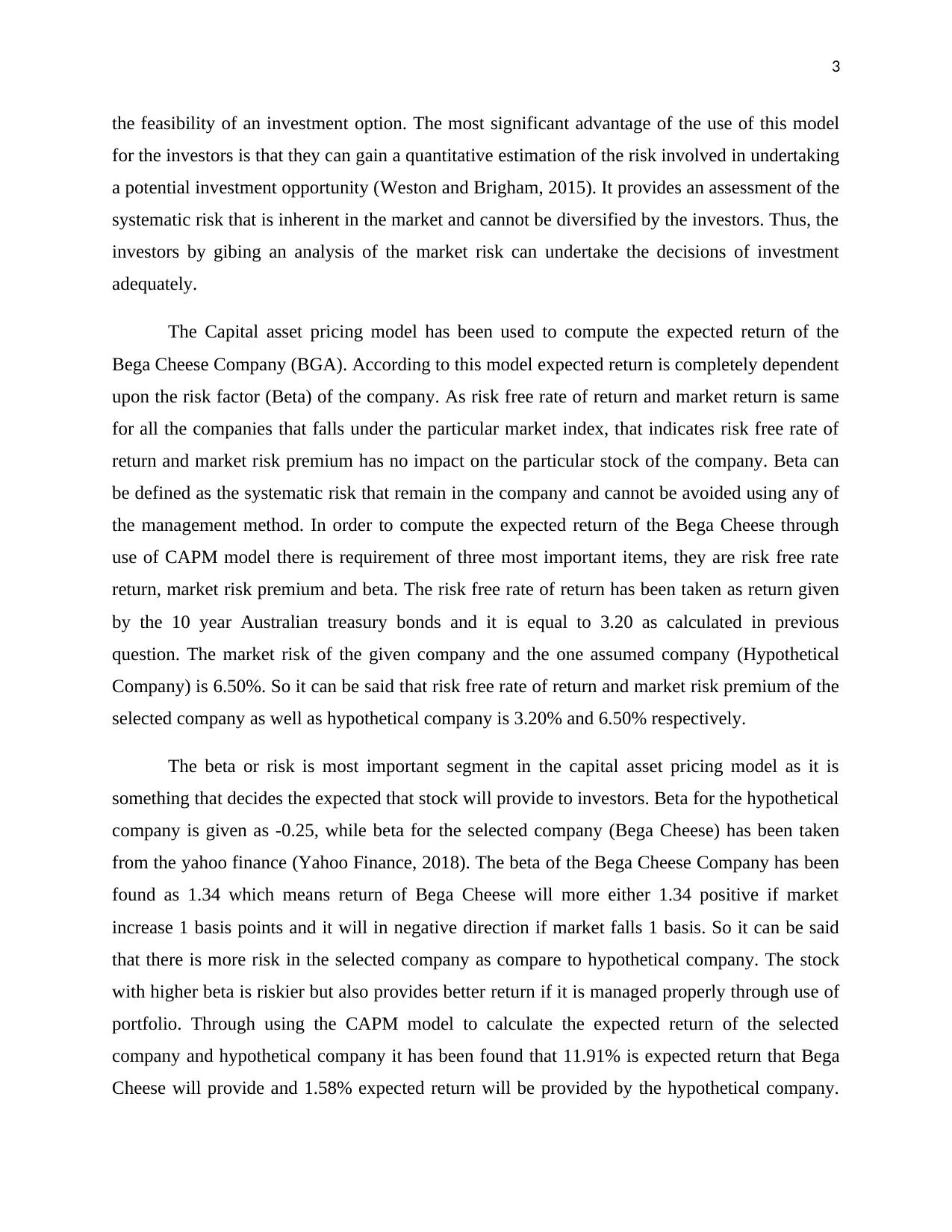
3
the feasibility of an investment option. The most significant advantage of the use of this model
for the investors is that they can gain a quantitative estimation of the risk involved in undertaking
a potential investment opportunity (Weston and Brigham, 2015). It provides an assessment of the
systematic risk that is inherent in the market and cannot be diversified by the investors. Thus, the
investors by gibing an analysis of the market risk can undertake the decisions of investment
adequately.
The Capital asset pricing model has been used to compute the expected return of the
Bega Cheese Company (BGA). According to this model expected return is completely dependent
upon the risk factor (Beta) of the company. As risk free rate of return and market return is same
for all the companies that falls under the particular market index, that indicates risk free rate of
return and market risk premium has no impact on the particular stock of the company. Beta can
be defined as the systematic risk that remain in the company and cannot be avoided using any of
the management method. In order to compute the expected return of the Bega Cheese through
use of CAPM model there is requirement of three most important items, they are risk free rate
return, market risk premium and beta. The risk free rate of return has been taken as return given
by the 10 year Australian treasury bonds and it is equal to 3.20 as calculated in previous
question. The market risk of the given company and the one assumed company (Hypothetical
Company) is 6.50%. So it can be said that risk free rate of return and market risk premium of the
selected company as well as hypothetical company is 3.20% and 6.50% respectively.
The beta or risk is most important segment in the capital asset pricing model as it is
something that decides the expected that stock will provide to investors. Beta for the hypothetical
company is given as -0.25, while beta for the selected company (Bega Cheese) has been taken
from the yahoo finance (Yahoo Finance, 2018). The beta of the Bega Cheese Company has been
found as 1.34 which means return of Bega Cheese will more either 1.34 positive if market
increase 1 basis points and it will in negative direction if market falls 1 basis. So it can be said
that there is more risk in the selected company as compare to hypothetical company. The stock
with higher beta is riskier but also provides better return if it is managed properly through use of
portfolio. Through using the CAPM model to calculate the expected return of the selected
company and hypothetical company it has been found that 11.91% is expected return that Bega
Cheese will provide and 1.58% expected return will be provided by the hypothetical company.
the feasibility of an investment option. The most significant advantage of the use of this model
for the investors is that they can gain a quantitative estimation of the risk involved in undertaking
a potential investment opportunity (Weston and Brigham, 2015). It provides an assessment of the
systematic risk that is inherent in the market and cannot be diversified by the investors. Thus, the
investors by gibing an analysis of the market risk can undertake the decisions of investment
adequately.
The Capital asset pricing model has been used to compute the expected return of the
Bega Cheese Company (BGA). According to this model expected return is completely dependent
upon the risk factor (Beta) of the company. As risk free rate of return and market return is same
for all the companies that falls under the particular market index, that indicates risk free rate of
return and market risk premium has no impact on the particular stock of the company. Beta can
be defined as the systematic risk that remain in the company and cannot be avoided using any of
the management method. In order to compute the expected return of the Bega Cheese through
use of CAPM model there is requirement of three most important items, they are risk free rate
return, market risk premium and beta. The risk free rate of return has been taken as return given
by the 10 year Australian treasury bonds and it is equal to 3.20 as calculated in previous
question. The market risk of the given company and the one assumed company (Hypothetical
Company) is 6.50%. So it can be said that risk free rate of return and market risk premium of the
selected company as well as hypothetical company is 3.20% and 6.50% respectively.
The beta or risk is most important segment in the capital asset pricing model as it is
something that decides the expected that stock will provide to investors. Beta for the hypothetical
company is given as -0.25, while beta for the selected company (Bega Cheese) has been taken
from the yahoo finance (Yahoo Finance, 2018). The beta of the Bega Cheese Company has been
found as 1.34 which means return of Bega Cheese will more either 1.34 positive if market
increase 1 basis points and it will in negative direction if market falls 1 basis. So it can be said
that there is more risk in the selected company as compare to hypothetical company. The stock
with higher beta is riskier but also provides better return if it is managed properly through use of
portfolio. Through using the CAPM model to calculate the expected return of the selected
company and hypothetical company it has been found that 11.91% is expected return that Bega
Cheese will provide and 1.58% expected return will be provided by the hypothetical company.
⊘ This is a preview!⊘
Do you want full access?
Subscribe today to unlock all pages.

Trusted by 1+ million students worldwide
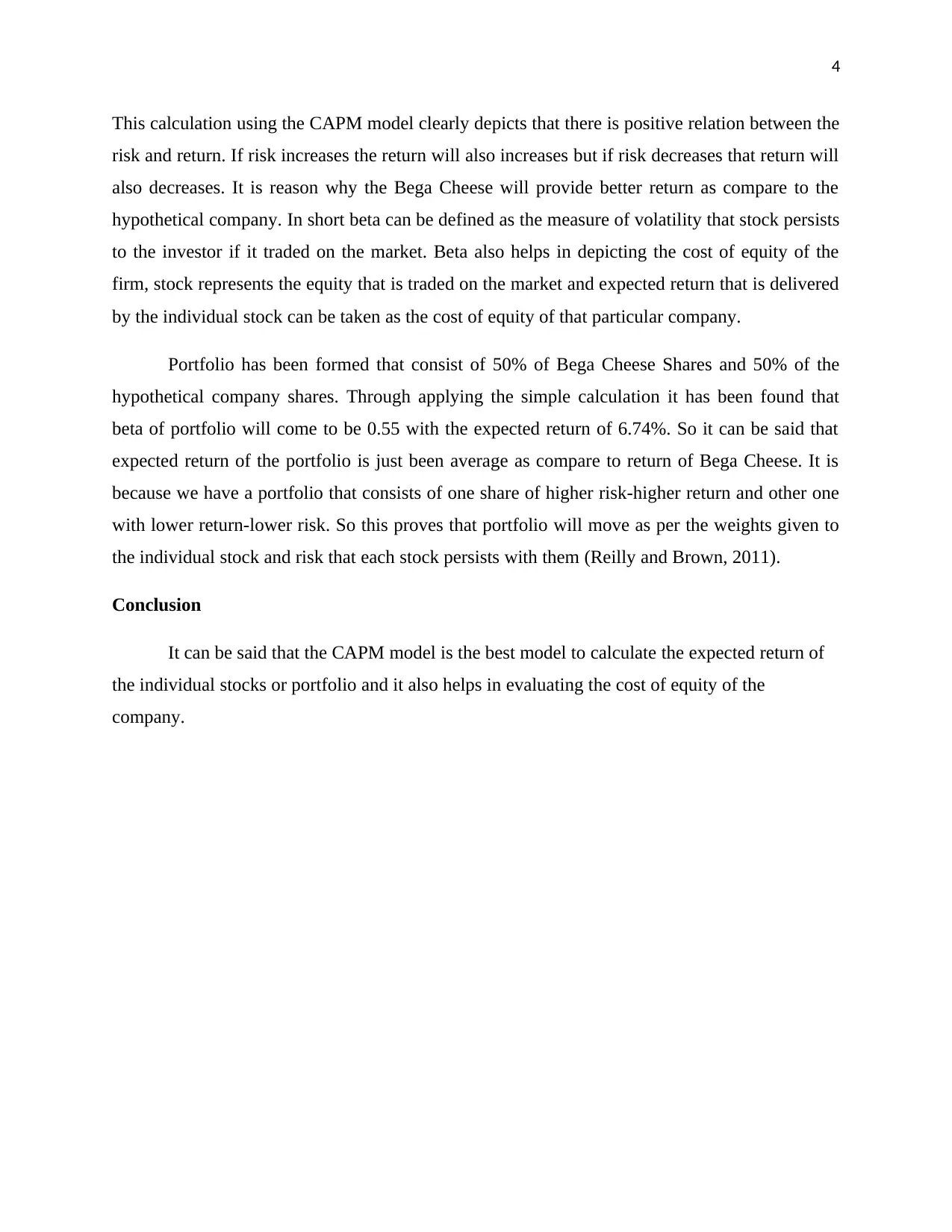
4
This calculation using the CAPM model clearly depicts that there is positive relation between the
risk and return. If risk increases the return will also increases but if risk decreases that return will
also decreases. It is reason why the Bega Cheese will provide better return as compare to the
hypothetical company. In short beta can be defined as the measure of volatility that stock persists
to the investor if it traded on the market. Beta also helps in depicting the cost of equity of the
firm, stock represents the equity that is traded on the market and expected return that is delivered
by the individual stock can be taken as the cost of equity of that particular company.
Portfolio has been formed that consist of 50% of Bega Cheese Shares and 50% of the
hypothetical company shares. Through applying the simple calculation it has been found that
beta of portfolio will come to be 0.55 with the expected return of 6.74%. So it can be said that
expected return of the portfolio is just been average as compare to return of Bega Cheese. It is
because we have a portfolio that consists of one share of higher risk-higher return and other one
with lower return-lower risk. So this proves that portfolio will move as per the weights given to
the individual stock and risk that each stock persists with them (Reilly and Brown, 2011).
Conclusion
It can be said that the CAPM model is the best model to calculate the expected return of
the individual stocks or portfolio and it also helps in evaluating the cost of equity of the
company.
This calculation using the CAPM model clearly depicts that there is positive relation between the
risk and return. If risk increases the return will also increases but if risk decreases that return will
also decreases. It is reason why the Bega Cheese will provide better return as compare to the
hypothetical company. In short beta can be defined as the measure of volatility that stock persists
to the investor if it traded on the market. Beta also helps in depicting the cost of equity of the
firm, stock represents the equity that is traded on the market and expected return that is delivered
by the individual stock can be taken as the cost of equity of that particular company.
Portfolio has been formed that consist of 50% of Bega Cheese Shares and 50% of the
hypothetical company shares. Through applying the simple calculation it has been found that
beta of portfolio will come to be 0.55 with the expected return of 6.74%. So it can be said that
expected return of the portfolio is just been average as compare to return of Bega Cheese. It is
because we have a portfolio that consists of one share of higher risk-higher return and other one
with lower return-lower risk. So this proves that portfolio will move as per the weights given to
the individual stock and risk that each stock persists with them (Reilly and Brown, 2011).
Conclusion
It can be said that the CAPM model is the best model to calculate the expected return of
the individual stocks or portfolio and it also helps in evaluating the cost of equity of the
company.
Paraphrase This Document
Need a fresh take? Get an instant paraphrase of this document with our AI Paraphraser
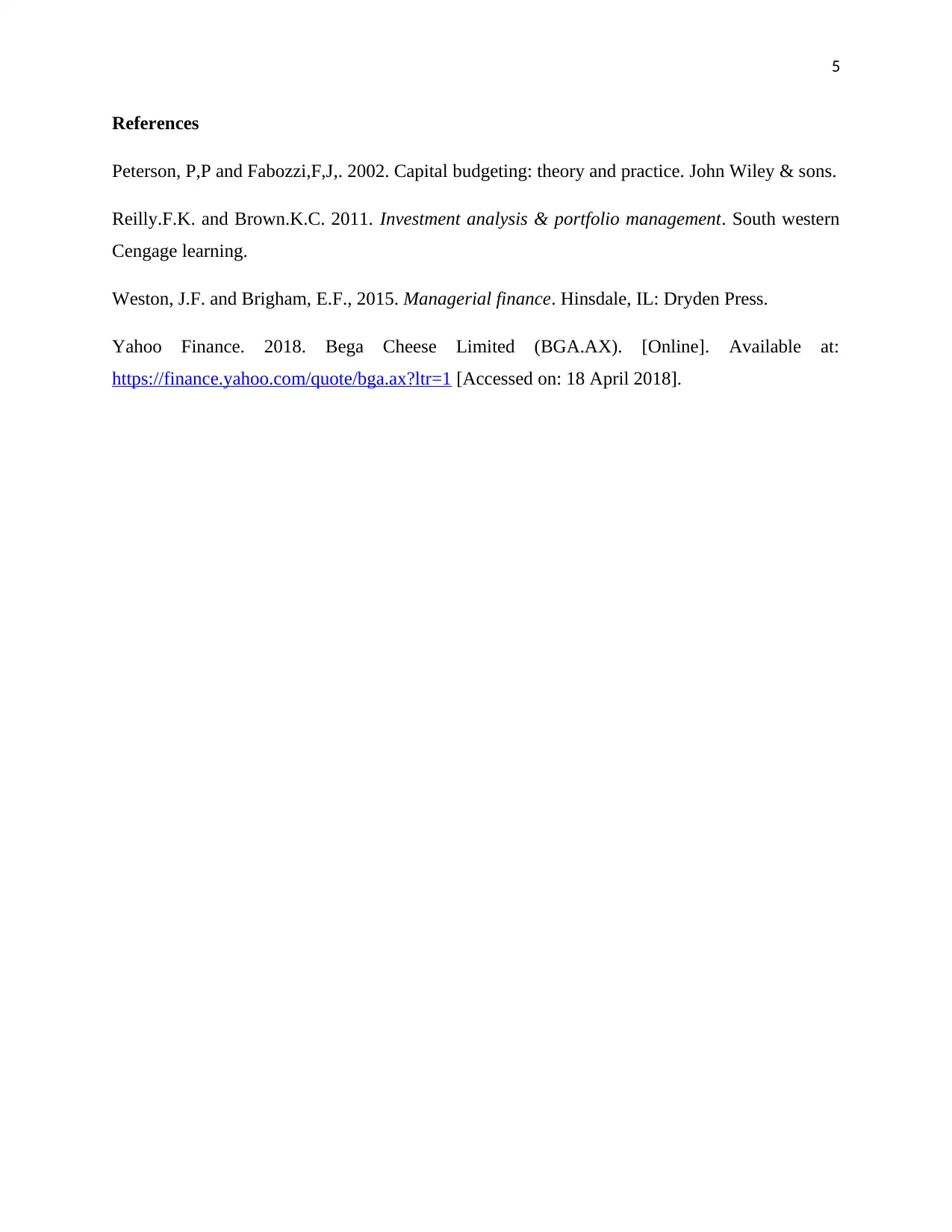
5
References
Peterson, P,P and Fabozzi,F,J,. 2002. Capital budgeting: theory and practice. John Wiley & sons.
Reilly.F.K. and Brown.K.C. 2011. Investment analysis & portfolio management. South western
Cengage learning.
Weston, J.F. and Brigham, E.F., 2015. Managerial finance. Hinsdale, IL: Dryden Press.
Yahoo Finance. 2018. Bega Cheese Limited (BGA.AX). [Online]. Available at:
https://finance.yahoo.com/quote/bga.ax?ltr=1 [Accessed on: 18 April 2018].
References
Peterson, P,P and Fabozzi,F,J,. 2002. Capital budgeting: theory and practice. John Wiley & sons.
Reilly.F.K. and Brown.K.C. 2011. Investment analysis & portfolio management. South western
Cengage learning.
Weston, J.F. and Brigham, E.F., 2015. Managerial finance. Hinsdale, IL: Dryden Press.
Yahoo Finance. 2018. Bega Cheese Limited (BGA.AX). [Online]. Available at:
https://finance.yahoo.com/quote/bga.ax?ltr=1 [Accessed on: 18 April 2018].
1 out of 5
Related Documents
Your All-in-One AI-Powered Toolkit for Academic Success.
+13062052269
info@desklib.com
Available 24*7 on WhatsApp / Email
![[object Object]](/_next/static/media/star-bottom.7253800d.svg)
Unlock your academic potential
Copyright © 2020–2025 A2Z Services. All Rights Reserved. Developed and managed by ZUCOL.



